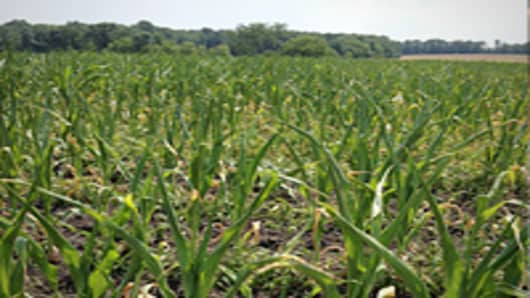Crop conditions continue to worsen, to levels not seen since the drought of 1988, threatening the size and quality of the U.S. corn crop as it enters a critical developmental stage.
The fresh USDA data, released Monday, shows that now just 48 percent of the corn planted across 18 states is in good to excellent condition, compared to 56 percent last week, and 69 percent at this time last year. Analysts had expected conditions to decline by just 5 percentage points to 51 percent.
Soybeans conditions also deteriorated but the crop is not at as important a stage. The USDA said 45 percent of the soybean crop is in good to excellent shape, compared to 53 percent last week.
“Corn should be seven to nine foot tall right now,” said Rich Nelson, head of research at Allendale. “All these reports of three to six foot corn is a little disappointing.”
Corn futures for December jumped more than 3.1 percent Monday, before the report. Corn finished at $6.55 per bushel, following last week’s double digit gains on worries hot, dry weather will result in a smaller yield. The crop, until recently, had been expected to be a record, as farmers planted the highest number of acres since the 1930s. But the hot, dry weather hitting the Midwesthas quickly changed those expectations.
The drought and heat are also hitting just as the corn crop in many states enters the important tasseling, or pollination phase. It needs wetter, cooler weather, in order for kernels to form properly. Hot, dry conditions are affecting about two-thirds of the corn belt, in locations such as eastern Iowa, Illinois, Indiana, and Ohio. But the northern part of the corn growing region is doing fairly well.
Nelson said the crop is the worst since 1988, but not nearly as bad. Then 23 percent of the crop was good to excellent at this time of year, and the drought then was national. Nelson expects this year’s crop to yield 145.3 bushels per acre, well below the 166 expected by USDA. He said the year’s trend is 161, and that would be a 10 percent decline from trend. In 1988, there was a 28 percent decline from trend.
Ashley Gulke, analyst wth Gulke Group, was driving in Illinois Monday. She said some fields looked very dry, and there was talk of some farmers swapping out corn to plant soybeans.
Nelson said he heard the same and expects it will be a small amount of acreage that gets replanted, but only after rains start to fall.
Gulke said the conditions are very variable across the region. For example, a Missouri farmer told her earlier that his crop was fine, but fields 20 miles in either direction were not in good shape.
Gulke's road trip also took her into Wisconsin, where she took a look at other fields.
“Just saw a field, thought it was onions—nope corn,” Gulke sent in a quick email.
“Beans look consistently pretty good,” she noted in an email.
Follow Patti Domm on Twitter: @pattidomm
Questions? Comments? Email us at marketinsider@cnbc.com



